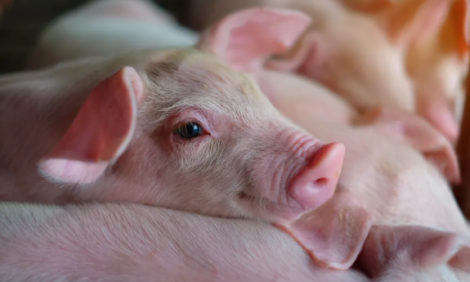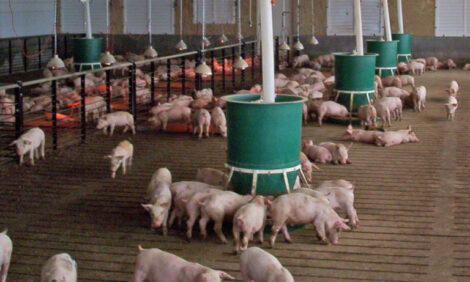



The different types of swine diet
By W.R. Walker and R.O. Myer, University of Florida Swine Extension - This article looks at the various types of swine diet that are required to take a piglet all the way through to a finisher. In total eight different types of diet are covered including those for Sows and Gilts.
There is a difference between "liquid-feeding systems" and "wet/dry feeding systems." With liquid feeding systems, water and feed are mixed prior to distributing to the feed troughs from which the pig eats. With wet/dry systems, dry feed is placed in a feeder (much like any self-feeder) and a nipple waterer is placed within the feeder that allows the pig(s) the opportunity to wet the feed, if it so chooses. So, feed can be consumed wet or dry. Wet/Dry feeding systems are very popular in swine production units in the U.S.
I hope you are able to download files attached to an e-mail message, because I am attaching a paper by Dr. R. H. Hines, Kansas State University, that talks about two different types of hog feeders, one of them being the wet/dry feeder. It provides research results where they conducted trials using this wet/dry feeding system.
Liquid Feeding
Piglets are weaned from the sow between 16 and 30 days of age on the majority of commercial pig units. However, weaning piglets at an earlier age may decrease the transmission of disease between dam and litter, and may also allow for an increases in piglets born per dam in a given amount of time. Therefore, increasing emphasis is being placed on the development and adoption of technology that allows piglets to be weaned at an earlier age. A major challenge to the early weaning of suckling piglets is that they have consumed very little solid food and have drunk little water prior to weaning. Consequently, placing the newly weaned pig on a dry pelleted diet may be an abrupt change that causes adverse effects on the feed intake of the pig. Liquid feeding, however, may buffer the transition of weaned piglets from liquid to dry diets. Liquid feeding may be described as the act of combining feed and water prior to or at the time of delivery to the feeding trough (Liptrap and Hogberg, 1991). Liquid feeding is well accepted by young pigs and has been shown to increase the dry matter intake and weight gain of piglets during the first four weeks post-weaning (Russel et al., 1996). In addition to improving the performance of weaned pigs, liquid feeding has been demonstrated to enhance gut health and function (Deperez et al., 1987). Some researchers have suggested that the improvement in performance is a result of the liquid feed being an appropriate medium for enzyme activity, digestion, nutrient absorption and microbial growth (Geary et al., 1996). However, the commercialization of liquid feeding is not with out significant challenges. Several researchers have found a significant reduction in piglet feed efficiency when liquid feeding was compared to dry feeding (Kornegay et al., 1981; Russel et al., 1996). These researchers hypothesized that the primary reason for poorer feed efficiency was due to an increase in feed wastage from the piglets jostling in feed troughs. Liquid feeding systems have unique applications in the nutritional management of weaned piglets that are not possible with alternative dry feeding strategies. Namely, the system=s role as a microbial fermenter and the enhanced ability to incorporate liquid food byproducts into the diets of young pigs. The mixing tank and pipeline delivery network of liquid feed systems can be allowed to become colonized with beneficial bacteria such as Lactobacillus spp which have been shown to reduce feed pH from 6 to 3.5 which inhibits the growth of E. Coli organisms in the feed (Russel et al., 1996). Piglets seemingly consume these diets regularly and the acidity of the feed may help to provide a sufficient supply of stomach acid for the newly weaned pig. Additionally, liquid feeding systems enhance the opportunity to utilize nutrient rich byproducts that may be incorporated into piglet diets and allow for improved growth rates (The National Committee for Pig Breeding, Health and Production, 1992). The utilization of liquid feeding systems in the nutritional management of newly weaned piglets is not new to the pork industry. However, the enhanced opportunities presented by new automated technology and the availability of lower costs feedstuffs may allow liquid feeding systems to become a practical component to piglet management in the commercial pig unit today. Liquid feeding systems are very popular in the European countries, but are used on a limited basis in the U.S. I can remember in the 70's when liquid feeding systems had a splurge in the U.S, then producers began to back away from them. I am going to list below the advantages and disadvantages of liquid feeding systems as I perceive them. LIQUID FEEDING IDEAS 1. Allows calculation of feed costs with computer-driven systems. 2. Lower manure volumes 3. Feed intake and feed efficiency should improve. 4. Can monitor day-to-day feed intakes and develop growth curves. 5. Pigs may grow more uniformly. 6. Alternative feeds/by-products are viable options. 7. Less dust in the building. 8. Easier to add medications. 9. Labor saving? 10. Less feed wastage. Disadvantages of Liquid Feeding Systems 1. Initial cost. 2. May need up to 10% more pen space. 3. If the computer goes down, the feeding system goes down. 4. Higher maintenance requirement (Special skills for repair work). 5. Slight learning curve to overcome. 6. Possibility of stale or spoiled feed. 7. Cleaning of feed lines and how often? Gilbert Hollis Extension Swine Specialist
Liquid Feeding
Piglets are weaned from the sow between 16 and 30 days of age on the majority of commercial pig units. However, weaning piglets at an earlier age may decrease the transmission of disease between dam and litter, and may also allow for an increases in piglets born per dam in a given amount of time. Therefore, increasing emphasis is being placed on the development and adoption of technology that allows piglets to be weaned at an earlier age. A major challenge to the early weaning of suckling piglets is that they have consumed very little solid food and have drunk little water prior to weaning. Consequently, placing the newly weaned pig on a dry pelleted diet may be an abrupt change that causes adverse effects on the feed intake of the pig. Liquid feeding, however, may buffer the transition of weaned piglets from liquid to dry diets. Liquid feeding may be described as the act of combining feed and water prior to or at the time of delivery to the feeding trough (Liptrap and Hogberg, 1991). Liquid feeding is well accepted by young pigs and has been shown to increase the dry matter intake and weight gain of piglets during the first four weeks post-weaning (Russel et al., 1996). In addition to improving the performance of weaned pigs, liquid feeding has been demonstrated to enhance gut health and function (Deperez et al., 1987). Some researchers have suggested that the improvement in performance is a result of the liquid feed being an appropriate medium for enzyme activity, digestion, nutrient absorption and microbial growth (Geary et al., 1996). However, the commercialization of liquid feeding is not with out significant challenges. Several researchers have found a significant reduction in piglet feed efficiency when liquid feeding was compared to dry feeding (Kornegay et al., 1981; Russel et al., 1996). These researchers hypothesized that the primary reason for poorer feed efficiency was due to an increase in feed wastage from the piglets jostling in feed troughs. Liquid feeding systems have unique applications in the nutritional management of weaned piglets that are not possible with alternative dry feeding strategies. Namely, the system=s role as a microbial fermenter and the enhanced ability to incorporate liquid food byproducts into the diets of young pigs. The mixing tank and pipeline delivery network of liquid feed systems can be allowed to become colonized with beneficial bacteria such as Lactobacillus spp which have been shown to reduce feed pH from 6 to 3.5 which inhibits the growth of E. Coli organisms in the feed (Russel et al., 1996). Piglets seemingly consume these diets regularly and the acidity of the feed may help to provide a sufficient supply of stomach acid for the newly weaned pig. Additionally, liquid feeding systems enhance the opportunity to utilize nutrient rich byproducts that may be incorporated into piglet diets and allow for improved growth rates (The National Committee for Pig Breeding, Health and Production, 1992). The utilization of liquid feeding systems in the nutritional management of newly weaned piglets is not new to the pork industry. However, the enhanced opportunities presented by new automated technology and the availability of lower costs feedstuffs may allow liquid feeding systems to become a practical component to piglet management in the commercial pig unit today. Liquid feeding systems are very popular in the European countries, but are used on a limited basis in the U.S. I can remember in the 70's when liquid feeding systems had a splurge in the U.S, then producers began to back away from them. I am going to list below the advantages and disadvantages of liquid feeding systems as I perceive them. LIQUID FEEDING IDEAS 1. Allows calculation of feed costs with computer-driven systems. 2. Lower manure volumes 3. Feed intake and feed efficiency should improve. 4. Can monitor day-to-day feed intakes and develop growth curves. 5. Pigs may grow more uniformly. 6. Alternative feeds/by-products are viable options. 7. Less dust in the building. 8. Easier to add medications. 9. Labor saving? 10. Less feed wastage. Disadvantages of Liquid Feeding Systems 1. Initial cost. 2. May need up to 10% more pen space. 3. If the computer goes down, the feeding system goes down. 4. Higher maintenance requirement (Special skills for repair work). 5. Slight learning curve to overcome. 6. Possibility of stale or spoiled feed. 7. Cleaning of feed lines and how often? Gilbert Hollis Extension Swine Specialist








